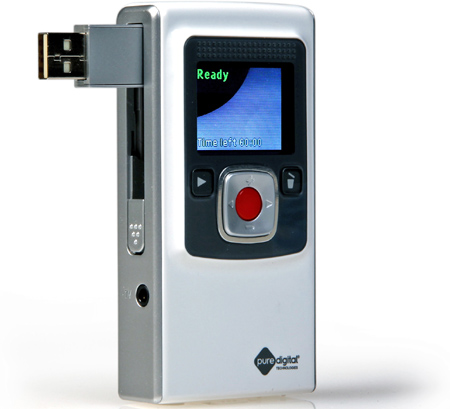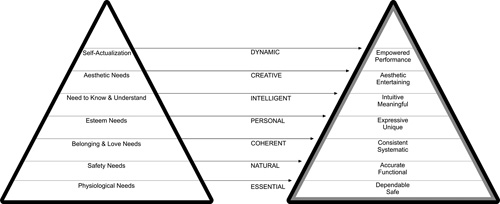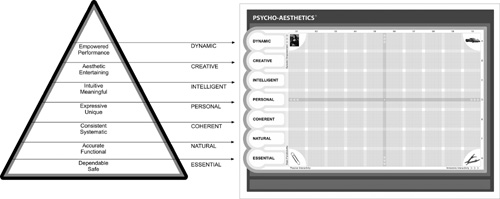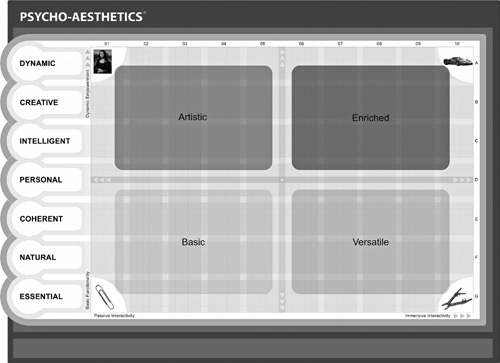3 Map the Future
Design is a process that begins with a deep understanding of the consumer. Consumer experience experts Lewis Carbone and Steve Haeckel wrote, “Customers always get more than they bargained for, because a product or service always comes with an experience. By experience we mean the take-away impression formed by people’s encounters with products, services, and businesses….”1 Great design begins with understanding the industry and competitive offerings according to consumer experience and empowerment.
But how can you evaluate subjective and intangible ideas such as experience and empowerment? Traditional tools for mapping the competition generally rely on analyzing pricing, margins, and market shares. Although these metrics will always be important, they don’t begin to capture the importance of the emotional connection that distinguishes market leaders in every category. Furthermore, financial measures give us a snapshot of today. To establish a direction for future innovation, the competitive landscape must be understood in the context of consumers. The key to developing truly breakthrough products and services can be found in first understanding the consumer experience and then innovating meaningful ways of transforming it. The very best innovations transform both the experience and the consumer.
Consider the runaway success of the Flip Video camcorder, which upon introduction quickly commanded 13 percent of the camcorder market despite the fact that 50 percent of its users already owned a cam-corder. For the two years prior to the Flip cam’s release, the camcorder category was stagnant. The outlook was grim with widespread expectations for decline. But the executives at Pure Digital Technologies, at the time an unknown player, saw things differently. They saw opportunity, so they boldly entered the market with a camcorder that had the point-and-click functionality of a Polaroid camera. The Flip cam’s small size made it easy to take anywhere, eliminating the need to tote around a camera bag. The picture quality was far superior to the other portable camcorder substitute—the cell phone—and the Flip cam performed above expectations in dimly lit environments. Best of all, its preloaded software and USB connector that “flipped” out at the press of a button made uploading videos to YouTube effortless. Soon after its release, the Flip cam became Amazon.com’s top-selling camcorder, and it surpassed sales expectations at major retailers. Bloggers began telling stories about their children and elderly relatives making and sharing video recordings minutes after taking the Flip cam out of the box.
This unbridled success was not the result of projecting the future of the camcorder technology. It was the result of a deep thought process about how to deliver a better consumer experience. Before the Flip cam, the essence of the consumer camcorder experience was confusing and difficult. Technophobes who could barely transfer pictures from their still digital cameras steered clear of the capable but complicated offerings on the camcorder aisle.
By recognizing this major untapped market, Pure Digital had the insight to bring fun and ease of use into the camcorder experience. They understood that people didn’t want to become videographers. They merely wanted to share the moments of their lives with the people they loved. By eliminating a few major pain points (challenges faced by consumers as they interact with a design) through stripping away unnecessary features and adding built-in USB and an automated uploading system, Flip became an extremely attractive option for a wide variety of users, finding its own niche in the “white-space” between cell phones, digital cameras, and existing camcorders. The stripped-down design of the Flip cam also allowed a price point of approximately $200—well within the reach of the college students and other new consumers Pure Digital was seeking to connect with.
The decisions about what features to include or leave out were not guided by a desire to outpace competitors. The consumer experience was the focus of Flip Video’s executive team as it sought to redefine the market. Though the camera was designed by Smart Design (with investment from IDEO), the mission of Pure Digital was clear. Simon Fleming-Wood, Vice President of marketing for Pure Digital Technologies, explains:
“When we started out, we had simplicity as our goal. There are two ways to go about simplicity—by making something stupid, or by making its benefits accessible. We initially tried to do a one-time-use camcorder, but there were business model challenges with that concept. But most of our consumers were women, and, in the traditional camcorder market, most of the buyers were hobbyists and dads…. We learned that moms were a big category that was left out.
“The camcorder market was stagnant when we began, but we saw that it was only about 1/6th the size of the still camera market. In fact, in 2000, we saw that the camcorder market was where the still camera market was 25–30 years prior. We were confident that there was great potential if the overall experience could be simplified to a point-and-click functionality.
“We knew that people really liked video, but we knew that the experience needed to be changed and that there was tremendous value in doing so. We also understood before the design process even began that the product was the market-ing…it had to be the thing that everyone talked about. In the end, we were able to create a beautiful device that is not intimidating to anyone.
“We were initially labeled ‘camcorder lite,’ but today there are pictures of Steven Spielberg and Steven Soderebergh using their Flip cams—and they certainly have knowledge and access to the best equipment. I think the simplicity that we built into the camera made it fun for the tech-savvy as well. Our success was really about re-imagining the future. It is really gratifying to see new products enter the market and refer to themselves as ‘the Flip of their category….’ Many of our competitors had all the capabilities we had, but they could not put the same package together.”2
Although the insight to begin with consumer experience makes sense when it is explained, it represents a major departure from the strategy development process in many organizations. When you’ve determined the desired consumer experience, this vision must be the focus of execution at every turn from strategy, design, and engineering to marketing. Notice, in discussing the Flip cam, there was no mention of pixels, memory, or other technical specifications. The strategy was pared down to three essentials: a) affordability for new consumer segments, b) ease of use, and c) ease of sharing content. There was no software to download or install to share content, no cords to tangle or lose. The Flip was battery-powered, so if you ran out of power on vacation, you weren’t out of luck because of a forgotten charger. You could just buy spare batteries at the nearest store. Best of all, the Flip was actually fun to use. It forever shortened the distance between capturing a memory and sharing it. The payoff of the consumer-centric design was obvious—sales reached almost two million units in less than two years.3
The camcorder industry quickly awoke to the idea that the relevant market for camcorders had suddenly expanded from the traditional techie hobbyists and dads to anyone who wanted and needed to record memories. At the same time as Flip gained market share, the industry was growing as well, due to the introduction of similar offerings from competitors.
Although existing consumers do look for new features in categories such as camcorders, the rules were rewritten, and the market expanded by creating a design that was simple and accessible. These designs infused the market with excitement and hordes of Flip cam evangelists eager to share their memories and their discovery of a better way to shoot and share video (see Figure 3.1).
© RKS Design
Figure 3.1 The Flip camcorder
Designing for Tomorrow’s Markets Today
Short of hiring a soothsayer, how can you predict what experience consumers want? Depending on your industry, development cycles may be anywhere from a few months to several years. It’s hard enough to predict what technical specifications will be possible in the near future, surely something as complex as “experience” must be even more challenging to anticipate. Looking at sales figures and internal cost structures forces the discussion into the present, not the future. Mapping margins and market share is no more effective. Though executives and stockholders may connect emotionally with market share, consumers do not. Statistics-based approaches also skew resources toward known revenue-generators at the expense of discovering where breakout innovations and future profits may reside. Teams working from strategy borne of market share examination can become focused on demonstrating compliance rather than vision. The products and services work, but they may no longer work for the consumer. When this happens, the ability to create new categories with staying power diminishes rapidly.
Experience Mapping Guides the Way
If margins and market shares aren’t the full answer, how then can a company translate the trends and data into products, services, and experiences that consumers actually want? How can data be gathered when standards are still emerging? And how can design focused on experience be leveraged to create business results?
These were the questions that sparked a long process of discovery and experimentation. The business battlefield is littered with fail-ures—attractive products that failed to connect with their audience. Although a variety of tools are available to measure consumers’ response to products and services after they’ve been created, development teams need to predict how to connect emotionally with diverse groups of consumers before beginning the development process.
With examination of notable successes and failures, we turned our attention to understanding the complex human emotions attached to the purchase and post-purchase experiences. New tools were developed to capture our lessons. For example, in doing research for Amana, we found that the competitive drive to show off to the neighbors co-existed with a deep desire to nurture family and friends. We quickly realized that we couldn’t talk about emotion without developing a common understanding among our clients and ourselves. For consumer insights to guide the design process, we had to be specific about what was relevant and within our power to influence. We also had to develop the tools in a way that they would connect with our audience at hand—the stakeholders within our clients’ companies.
We worked with anthropologists and academics to formalize the intuitive process our design teams had been using for years. Our goal was to develop a methodology that could help us create a predictable process for identifying strategic opportunities to create breakthrough consumer experiences. What was needed was a way to visualize the marketplace in the context of consumer emotions and experience. To do this, we created Psycho-Aesthetics® mapping.
Mapping Emotions
Psycho-Aesthetics maps are X–Y grids where the vertical axis represents emotion and the horizontal axis represents interactivity. Emotion and interactivity combine to form experience. To quantify emotion, we looked to the foundational psychological theory expressed in Maslow’s Hierarchy of Needs. This hierarchy illustrates how human needs and emotions are prioritized. Physiological needs are the needs for the most basic things required to survive—food, water, shelter, and so on. These survival needs must be met before we seek to satisfy our needs for security. As each level of needs is met, we can move up the pyramid, gradually moving through the needs for love and esteem until reaching self-actualization, the pinnacle of human development, in which we have become the best possible version of ourselves.
Psycho-Aesthetics translates Maslow’s Hierarchy of Needs into a Consumer’s Hierarchy of Needs, Desires, and Aspirations, as shown in Figure 3.2. In the Consumer’s Hierarchy, the first level represents the products and experiences that satisfy the most basic needs in a category. These get the job done, but they don’t significantly transform a consumer’s life or their outlook on life.
A study of our own history and that of iconic brands revealed that the biggest successes had one thing in common: The products and experiences that people bonded with were the ones that made them feel good about themselves. Nike shoes make people feel like better athletes. Organic produce makes people feel like better providers. Luxury cars make people feel successful. These are the things that do more than simply get the job done. They enable people to become more. Think of what a global positioning system (GPS) does for a nervous driver or the perfect suit does for the nervous job seeker. Products and experiences that satisfy higher-level needs help people become more evolved versions of themselves.
© RKS Design
Figure 3.2 Transformation of Maslow’s Hierarchy of Needs (left) to Consumer’s Hierarchy of Needs, Desires, and Aspirations (right)
In the Consumer’s Hierarchy, Dynamic Empowerment is the pinnacle of consumer desires, needs, and aspirations. The most meaningful consumer experiences provide this high level of empowerment. By empowerment, we mean the emotional connections we make with products and services because they help us to do things we couldn’t do (or couldn’t do as well) without them. They may do this by giving us more time (a dishwasher), by allowing us to connect (Skype, Facebook), or by adding fun to our lives (Wii). There are products and services in every category that empower us to different degrees, and they often change the way we interact with the world around us.
When consumers feel empowered, they develop a profound emotional bond with the products that enabled this transformation (see Figure 3.3). This leads to brand loyalty and evangelism, offering an opportunity to radically change not only consumer lives, but also the direction of firms and entire industries.
© RKS Design
Figure 3.3 Maslow’s Hierarchy and the Psycho-Aesthetics Map. The Hierarchy corresponds to the vertical (Y) axis.
Engaging Interactivity
Interactivity is the second dimension of consumer experience represented on Psycho-Aesthetics maps. The horizontal (or X) axis is based on the design’s level of interactivity…from passive interactivity to highly immersive. Although function can be a part of a design’s level of interactivity, this axis also serves to measure how many senses are activated and how deeply engaging the overall interactivity is.
Interactivity also considers the way in which people come to adopt—or dismiss the things they encounter in their daily lives. We use the degree to which a consumer is compelled to interact (play, examine, test-drive) with an offering to judge this. Interactivity can be observed reliably and is highly correlated with interest and purchase behaviors. Companies succeed when they engage as many senses as possible. People who touch products are more likely to buy them. Grocery store receipts increase when music is played. And who hasn’t fallen prey to the allure of that “new car smell”?
Interactivity can be seen and measured. One of the most successful illustrations of this idea was our work on Teddy Ruxpin, the toy indus-try’s first computer-animated, talking stuffed bear. It is still one of the best selling toys of all time. Children have always engaged in play-acting and many toys at the time were offering more sensory feedback (such as Strawberry Shortcake, which had a particular scent) and more accessories, varieties, and features (for example, the Barbie and GI Joe franchises). Teddy Ruxpin actually spoke back to children and interacted with them. This wasn’t just a toy; this was their friend. The technology inside of Teddy and the mechanisms required to change the audio tapes had to be carefully crafted to make sure that the illusion was not destroyed. Rather than engaging in passive play, which can quickly become boring, children played with Teddy Ruxpin for longer periods of time, became more attached, and created elaborate adventures involving the bear. This increased level of involvement with the brand created a success that continues to the present day: Since its inception in 1985, more than 20 million units of Teddy Ruxpin toys and merchandise have been sold worldwide. Brand recognition remains at a high 80 percent.4
As illustrated by Teddy Ruxpin, the amount of interaction that is encouraged by the design is a critical test of its success. Although there are devices such as the garage door opener that need to work at the touch of the button and then fade quickly into the background, these products rarely generate that consumer fervor that leads to explosive growth. More deeply engaging experiences move people and can turn them quickly into brand evangelists. Listening to a music CD is, for the most part, a passive act. The iTunes/iPod experience allows consumers to easily and immediately download a song to their iPod so that it can be enjoyed as part of an exercise routine or commute engages the consumer as it elevates the experience. Now look at Guitar Hero. By enabling the consumer to become an active participant in the music, the gaming franchise was propelled past the $1 billion mark in North America in a record 26 months. The choice to participate rather than be a passive bystander is a powerful lure at any age.
Mapping Out the Possibilities
This mapping enables powerful analyses of personas, competitive products, brands and more, all as seen through the lens of consumer experience. Items placed on these maps fall into one of four quadrants: Basic, Versatile, Artistic, and Enriched, as shown in Figure 3.4.
© RKS Design
Figure 3.4 Psycho-Aesthetics map with quadrants named
• Basic quadrant—In the lower-left quadrant of the Psycho-Aesthetics map is a paper clip. This represents a product that is purely functional and requires little involvement from the user. The lower-left quadrant would include very basic items that have limited purposes (for example, a bare-bones can opener).
• Versatile quadrant—On the lower-right quadrant, a multi-tool offers high levels of functionality and invites interaction from the user. Complex technology and multiuse devices dominate this quadrant.
• Artistic quadrant—On the upper-left quadrant is the Mona Lisa, which represents pure beauty but does not provide much function or interaction. Items in this category include high-end fashion and jewelry.
• Enriched quadrant—Represented in the upper-right corner by the Ferrari, items in this quadrant combine function and beauty. They engage multiple senses—visual, tactile (leather, controls), auditory (the distinctive purr of the engine). These purchases are driven by higher-level emotional needs and motivated by the consumer’s desire for self-expression. Our choices in homes and cars are good examples of lifestyle and recreation purchases that result in immersive and empowering experiences.
Although the Mona Lisa and Ferrari represent high levels of beauty and high levels of interactivity and empowerment, respectively, they do not necessarily translate into high price points. This mapping tool is as relevant for entry-level products as it is for high-end ones. The idea of using products to represent the corners of the map is to provide a reference point for experience that everyone in the team can relate to. The goal is to understand the specific experiences that will be valuable to target consumers—whatever the segment may be.
One caveat is that the number of interactions does not equate to the quality of consumer experience. A positive experience depends on the degree to which people can control their interactions and get feedback that they want. Anyone scrolling through Amazon.com can determine the level of detail in which they want to research a particular item. However, ordering is not the place where consumers want to navigate multiple screens—and Amazon knows that. One-click ordering is an equally important part of the equation. Understanding where effort will help you bond with consumers and where it will repel them is at the heart of good design. The experience of actually using a product or service needs to be considered along with the experiences that they enable.
A map of the cell phone industry can help to illustrate the concept of mapping products, as shown in Figure 3.5.
© RKS Design
Figure 3.5 Psycho-Aesthetics map showing competitive landscape for cell phones
If we look at the map of cell phones, the Basic quadrant includes phones for those who are interested primarily in calling. They may seek out a cell phone to take with them in emergencies or maintain contact with family members. They need something simple and easy to use.
The Artistic quadrant includes the phones that have a high degree of personal style. The aesthetics of the phone are distinctive and the primary basis of attraction for this consumer. Some of these consumers may also be seeking out kits and accessories to decorate and beautify other phones—or limited edition colors and designs to show self-expression.
In the Versatile quadrant are phones that have multiple functions such as email access, data feeds, or a camera. People in this quadrant likely depend on their phone for professional and personal use and are looking for reliability.
The Enriched quadrant would require creating a phone that combines multiple functions with style and engaging features that can be used for fun and entertainment as well as for work. This is a new area of competition today.
Strategy Based on Understanding
We can begin to understand how an industry is evolving by placing competitive products or services on the map. Which companies just get the job done (paper clip)? Who offers beautiful objects that don’t necessarily engage you in a rich multisensory experience (Mona Lisa)? Which items offer interaction but don’t necessarily create rich, empowering experience? Where are the examples in your industry of the Ferrari—a combination of beauty and immersive interactivity? The placement of various offerings on the map is a qualitative assessment, but it can quickly and efficiently establish direction by highlighting the gaps in current offerings in terms of the consumer experience.
Team collaboration in this stage is highly encouraged. Inclusion of all departmental functions playing a role in implementation will develop the consensus and vision required to create meaningful innovation. Because the information is represented visually, it can be easily recorded and referenced throughout the design process. And going back to visual reference points of your strategy is a critical part of helping teams to keep the product development process focused on the vision of creating a better consumer experience.
Experience Mapping and the Power of Design
If we look back at the Flip camcorder example, we can see how the power of design can shift a product or service from one quadrant to another. Before the Flip cam, the competitive landscape for camcorders was largely clustered in the “versatile” quadrant as both existing consumers and products were focused on technology and features. The executives at Pure Digital realized there was a massive, untapped, market segment in the upper-left quadrant. By reducing complexity and adding fun and style, the Flip cam appealed to these consumers who were driven by the emotional need to connect and share their memories with loved ones but lacked an affinity for the highly technical.
Pure Digital’s success came out of its instinctive application of these principles. But even if you’re blessed with a flash of insight, without a robust innovation and design process, the odds are stacked against repeated success. Furthermore, corporations rarely make decisions based on instinct. A rational basis for understanding and analysis is required for stakeholder and investor buy-in. And this is exactly what Psycho-Aesthetics provides. In the next few chapters, you learn how to use the suite of tools to methodically and repeatably uncover the emerging opportunities in your industry.





